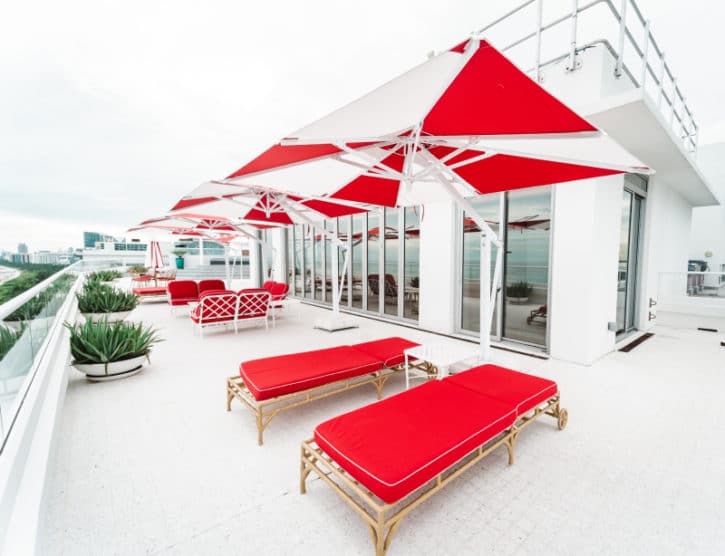How Outdoor Umbrellas Are Made

Outdoor umbrellas may look similar, but the way they are manufactured has a significant impact on the durability and quality of the finished product. From the materials used to the way they were manufactured, there are a number of factors that separate outdoor umbrellas in terms of value for money.
If you’re in the market for an outdoor umbrella, this blog will explain a few details about how umbrellas are made so that you know what to look for in terms of quality and longevity.
 Outdoor umbrellas are made with various different materials depending on the function and affordability the manufacturer is aiming for.
The Canopy: Umbrella canopies can be made from a variety of materials, most commonly acrylic, polyester, or tensile structure fabric (PVC). Polyester is usually used for cheaper umbrellas, but there are exceptions. Polyester that is dyed with a solution-dying process rather than a stock-dying process tends to be more durable and less likely to fade or tear than other polyester options.
The Base: Umbrellas can have either a solid or a filled base; solid bases typically provide the most stability. When it comes to solid bases, concrete, steel, and cast iron are the most popular materials. Cheaper base options are often filled with sand or water, but these do not provide the stability that a solid base would, so if you are in a very windy area, solid bases would be more functional.
The Frame: The most common frame/ or pole materials are stainless steel, aluminum, plastic, and wood. The type you choose will depend on what you will be using the umbrella for and the environment it will be in. Aluminum is the most popular option because it is both rust and moisture-resistant, while steel is heavier and more expensive. Plastic and wood, on the other hand, may not have the durability and lifespan of the other material options.
Outdoor umbrellas are made with various different materials depending on the function and affordability the manufacturer is aiming for.
The Canopy: Umbrella canopies can be made from a variety of materials, most commonly acrylic, polyester, or tensile structure fabric (PVC). Polyester is usually used for cheaper umbrellas, but there are exceptions. Polyester that is dyed with a solution-dying process rather than a stock-dying process tends to be more durable and less likely to fade or tear than other polyester options.
The Base: Umbrellas can have either a solid or a filled base; solid bases typically provide the most stability. When it comes to solid bases, concrete, steel, and cast iron are the most popular materials. Cheaper base options are often filled with sand or water, but these do not provide the stability that a solid base would, so if you are in a very windy area, solid bases would be more functional.
The Frame: The most common frame/ or pole materials are stainless steel, aluminum, plastic, and wood. The type you choose will depend on what you will be using the umbrella for and the environment it will be in. Aluminum is the most popular option because it is both rust and moisture-resistant, while steel is heavier and more expensive. Plastic and wood, on the other hand, may not have the durability and lifespan of the other material options.
 The frame size is not usually depicted in the name as it is with canopy sizes. Typically, you would choose the size of the canopy you want and try to find a frame size to accommodate it. You can choose from a number of umbrella types, such as center-post and cantilever, but your frame measurement will differ depending on which one you choose.
It is typically measured in terms of height, clearance of the closed arms, pole width, and the weight of a frame. Choosing the best size and shape for your needs is crucial to achieving the atmosphere you want, so be sure to bring any questions you may have to your supplier’s attention.
The frame size is not usually depicted in the name as it is with canopy sizes. Typically, you would choose the size of the canopy you want and try to find a frame size to accommodate it. You can choose from a number of umbrella types, such as center-post and cantilever, but your frame measurement will differ depending on which one you choose.
It is typically measured in terms of height, clearance of the closed arms, pole width, and the weight of a frame. Choosing the best size and shape for your needs is crucial to achieving the atmosphere you want, so be sure to bring any questions you may have to your supplier’s attention.
The Manufacturing Process
More budget-friendly outdoor umbrellas tend to be mass-produced in countries like China or Taiwan. While this does allow people access to more affordable options, these umbrellas lack the quality and longevity you would expect to get from a more expensive manufacturer that prioritizes making high-quality products. The two main components of any outdoor umbrella are the canopy and the frame. Oftentimes, these components are made separately in the manufacturing process.The Types Of Materials for Outdoor Umbrellas
 Outdoor umbrellas are made with various different materials depending on the function and affordability the manufacturer is aiming for.
The Canopy: Umbrella canopies can be made from a variety of materials, most commonly acrylic, polyester, or tensile structure fabric (PVC). Polyester is usually used for cheaper umbrellas, but there are exceptions. Polyester that is dyed with a solution-dying process rather than a stock-dying process tends to be more durable and less likely to fade or tear than other polyester options.
The Base: Umbrellas can have either a solid or a filled base; solid bases typically provide the most stability. When it comes to solid bases, concrete, steel, and cast iron are the most popular materials. Cheaper base options are often filled with sand or water, but these do not provide the stability that a solid base would, so if you are in a very windy area, solid bases would be more functional.
The Frame: The most common frame/ or pole materials are stainless steel, aluminum, plastic, and wood. The type you choose will depend on what you will be using the umbrella for and the environment it will be in. Aluminum is the most popular option because it is both rust and moisture-resistant, while steel is heavier and more expensive. Plastic and wood, on the other hand, may not have the durability and lifespan of the other material options.
Outdoor umbrellas are made with various different materials depending on the function and affordability the manufacturer is aiming for.
The Canopy: Umbrella canopies can be made from a variety of materials, most commonly acrylic, polyester, or tensile structure fabric (PVC). Polyester is usually used for cheaper umbrellas, but there are exceptions. Polyester that is dyed with a solution-dying process rather than a stock-dying process tends to be more durable and less likely to fade or tear than other polyester options.
The Base: Umbrellas can have either a solid or a filled base; solid bases typically provide the most stability. When it comes to solid bases, concrete, steel, and cast iron are the most popular materials. Cheaper base options are often filled with sand or water, but these do not provide the stability that a solid base would, so if you are in a very windy area, solid bases would be more functional.
The Frame: The most common frame/ or pole materials are stainless steel, aluminum, plastic, and wood. The type you choose will depend on what you will be using the umbrella for and the environment it will be in. Aluminum is the most popular option because it is both rust and moisture-resistant, while steel is heavier and more expensive. Plastic and wood, on the other hand, may not have the durability and lifespan of the other material options.
How Umbrellas Are Measured
Size is a major component of finding the right outdoor umbrella for your needs. You need to take the size, shape, and purpose into consideration to make sure you are getting enough shade from the canopy but also that the frame size is not too big or small for the area you have available. This is why it is important to know how to accurately measure your umbrella.Umbrella Canopies
The way umbrella canopies are measured is dependent on the size and shape when the umbrella is open. The two most common outdoor umbrella shapes are octagons and squares (even though they can be available in round, rectangular, or even hexagonal shapes). The measurement of an octagonal umbrella will be determined according to the diameter of the canopy when it is open, while square umbrellas are measured according to their width. When square umbrellas are open, they can be measured from any side, as they are all the same. However, with shapes that have sides that are not equal, the longest side is measured. It is rare, but some manufacturers may even tell you the circumference of the umbrella along with its diameter, so just keep an eye out for this while shopping to prevent you from accidentally buying the wrong size.Umbrella Frames
 The frame size is not usually depicted in the name as it is with canopy sizes. Typically, you would choose the size of the canopy you want and try to find a frame size to accommodate it. You can choose from a number of umbrella types, such as center-post and cantilever, but your frame measurement will differ depending on which one you choose.
It is typically measured in terms of height, clearance of the closed arms, pole width, and the weight of a frame. Choosing the best size and shape for your needs is crucial to achieving the atmosphere you want, so be sure to bring any questions you may have to your supplier’s attention.
The frame size is not usually depicted in the name as it is with canopy sizes. Typically, you would choose the size of the canopy you want and try to find a frame size to accommodate it. You can choose from a number of umbrella types, such as center-post and cantilever, but your frame measurement will differ depending on which one you choose.
It is typically measured in terms of height, clearance of the closed arms, pole width, and the weight of a frame. Choosing the best size and shape for your needs is crucial to achieving the atmosphere you want, so be sure to bring any questions you may have to your supplier’s attention.